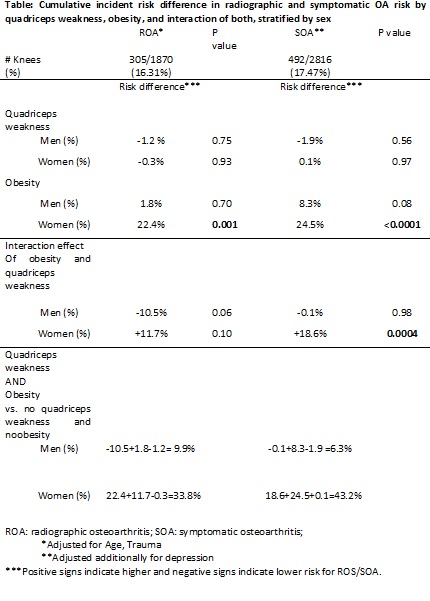Session Information
Session Type: Poster Session D
Session Time: 9:00AM-11:00AM
Background/Purpose: Quadriceps weakness is associated with an increased risk of incident symptomatic and radiographic knee osteoarthritis (OA), particularly in women. Stronger quadriceps muscles may confer a protective effect by acting as shock absorbers and joint stabilizers, especially if excess load across the joint is conferred by obesity, one of the strongest known risk factors for knee OA. Compared to men, women are more likely to have weaker quadriceps muscles leading to joint instability and articular damage. Thus, we investigated whether increased loading with obesity works synergistically with quadriceps weakness to increase the risk of developing knee OA, and whether this effect differs in men versus women.
Methods: We included participants from the Multicenter Osteoarthritis (MOST) Study, a NIH-funded longitudinal cohort of adults with or at risk for knee OA. Isokinetic quadriceps strength from baseline was categorized into sex-specific tertiles, with quadriceps weakness defined as being in the lowest tertile (yes/no). Obesity (yes/no) was defined as body mass index ≥30kg/m2 at baseline. Our outcomes at 60-month follow-up were incident radiographic OA (ROA) (KL-grade ≥2) and symptomatic OA (SOA) (radiographic OA with frequent knee pain in the same knee), among those without ROA and SOA, respectively at baseline. To determine the synergistic effect of quadriceps weakness and obesity on the risk of knee OA, we performed knee based, sex-stratified log-binomial regression models, calculating beta coefficients to estimate the risk differences, adjusting for pertinent confounders.
Results: At baseline, mean age was 61yrs, 58% women, mean BMI 29.4 kg/m2. By 60 month follow up, 305 out of 1870 knees (16.31%) developed incident ROA and 492 of 2816 knees (17.47%) SOA. Obese women had 22% more risk of incident ROA than nonobese women. Although quadriceps weakness did not affect the risk difference for incident ROA, there was a trend towards obese women’s risk being 34% more for developing ROA with concomitant quadriceps weakness than those without obesity and quadriceps weakness (p = 0.10 interaction of weakness and obesity). Obese women had a 24% higher incidence of SOA than nonobese women. Quadriceps weakness itself did not affect SOA risk (< 1% risk difference) in women but obese women’s risk with quadriceps weakness had a 43% higher risk of SOA incidence than nonobese and non-weak women (p= 0.0004 interaction of weakness and obesity). In men, neither obesity, quadriceps weakness nor their combination had significant effect on risk of either ROA or SOA. See Table.
Conclusion: We found the presence of obesity with quadriceps weakness to have a synergistic effect on higher risk of radiographic and symptomatic knee OA in women, but did not find any significant effect of obesity, quadriceps weakness, or the combination of the two on the risk of these outcomes in men.
To cite this abstract in AMA style:
Rubio J, Felson D, Chen X, Bacon K, Segal N, Nevitt M, Lewis C, Neogi T, Misra D. Synergistic Effect of Quadriceps Weakness and Obesity in Women at Risk of Knee Osteoarthritis [abstract]. Arthritis Rheumatol. 2020; 72 (suppl 10). https://acrabstracts.org/abstract/synergistic-effect-of-quadriceps-weakness-and-obesity-in-women-at-risk-of-knee-osteoarthritis/. Accessed .« Back to ACR Convergence 2020
ACR Meeting Abstracts - https://acrabstracts.org/abstract/synergistic-effect-of-quadriceps-weakness-and-obesity-in-women-at-risk-of-knee-osteoarthritis/

